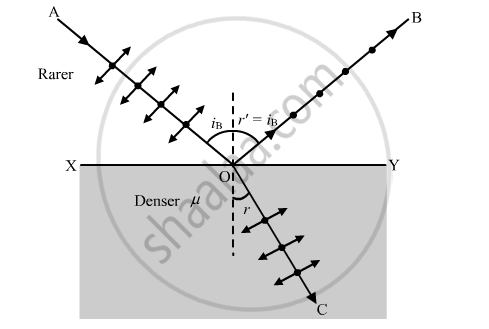Advertisements
Advertisements
Question
A beam of unpolarised light is incident on a glass-air interface. Show, using a suitable ray diagram, that light reflected from the interface is totally polarised, when μ = tan iB, where μ is the refractive index of glass with respect to air and iB is the Brewster's angle.
Solution

When unpolarised light is incident on the glass-air interface at Brewster angle iB, then reflected light is totally polarised. This is called Brewster's Law.
When light is incident at Brewster angle, the reflected component OB and the refracted component OC are mutually perpendicular to each other.
From the figure, we have
∠BOY + ∠YOC = 900
( 900 − iB ) + ( 900 − r ) = 900
where, r is angle of refraction
900 − iB = r
According to the Snell's law:
`mu=sini/sinr`
i = iB and r = (900 − iB)
`mu=sini_B/sin(90^@-i_B)=sini_B/cosi_B`
μ =tan iB
Hence proved.
APPEARS IN
RELATED QUESTIONS
For a glass plate as a polariser with refractive index 1.633, calculate the angle of incidence at which light is polarised.
Why does an unpolarised light incident on a polaroid get linearly polarised ?
Show, via a suitable diagram, how unpolarised light can be polarised by reflection.
A ray of light passes from a vacuum to a medium of refractive index (μ). The angle of
incidence is found to be twice the angle of refraction. The angle of incidence is _______.
A) `cos^(-1)(mu/2)`
B) cos−1(μ)
C) `2 cos^(-1) (mu/2)`
D) `2 sin^(-1) (mu/2)`
What is the difference between polarised light and unpolarised light?
Greenlight is an incident at the polarising angle on a certain transparent medium. The angle of refraction is 30°.
Find
(i) polarising angle, and
(ii) refractive index of the medium.
Light transmitted by Nicol prism is ______.
What is polarisation?
List the uses of polaroids.
An unpolarized light beam is incident on the polarizer of a polarization experiment and the intensity of light beam emerging from the analyzer is measured as 100 Lumens. Now, if the analyzer is rotated around the horizontal axis (direction of light) by 30° in clockwise direction, the intensity of emerging light will be ______ Lumens.
